Characterization Techniques |
|
Mettler Toledo TGA/SDTA 851e Thermogravimetric and Differential Thermal Analyzer
 Mettler Toledo TGA/SDTA 851e model that operates in the range 25 - 1100ºC provided with an ultramicrobalance with sensitivity of 0.1 μg. FACT (Fully Automated Calibration Technology) automatic weight calibration integrated.
Mettler Toledo TGA/SDTA 851e model that operates in the range 25 - 1100ºC provided with an ultramicrobalance with sensitivity of 0.1 μg. FACT (Fully Automated Calibration Technology) automatic weight calibration integrated.Simple and reliable operation. Parallel guided balance design compensates automatically for positioning errors. FlexCal automatically corrects for heating rate, type of crucible, module and purge gas. Rugged, horizontal furnace design minimizes influence of disturbing effects. Thermogravimetry (TGA) is a technique that measures the change in weight of a sample as it is heated or held at constant temperature. Its main use is to characterize materials with regard to their composition. SDTA allows simultaneous measurement of thermal effects and provides calorimetric data with high temperature accuracy.
Mettler Toledo DSC 821e Differential Scanning Calorimeter
 Mettler Toledo DSC 821e model that operates in the temperature range -150 - 500ºC equipped with a liquid nitrogen cryostat and a 200W furnace supply which allows maximum heating rates of 20ºC/min.
Mettler Toledo DSC 821e model that operates in the temperature range -150 - 500ºC equipped with a liquid nitrogen cryostat and a 200W furnace supply which allows maximum heating rates of 20ºC/min.Ceramic sensor plate guarantees robustness and design flexibility. Circular thermocouple arrangement for excellent baseline stability without mathematical data manipulation. Provided with a robust 34-sample position autosampler robot for high sample throughput, reproducible sample handling and allowing 24-hour operation. Optic fiber option for photocalorimetry measurements.
SQUID magnetometer, model Quantum Design MPMS-XL-5
 The Quantum Design MPMS 5XL SQUID Magnetometer is a very sensitive tool to measure the magnetization of materials, as a function of the temperature and magnetic field. The SQUID (Superconducting Quantum Interference Device) technology allows monitoring of very small changes in magnetic flux in order to discover the magnetic properties of samples.
The Quantum Design MPMS 5XL SQUID Magnetometer is a very sensitive tool to measure the magnetization of materials, as a function of the temperature and magnetic field. The SQUID (Superconducting Quantum Interference Device) technology allows monitoring of very small changes in magnetic flux in order to discover the magnetic properties of samples. Operating in the temperature range of 1.8-400 K (maximum sweeping rate 10K/min) and magnetic fields up to ± 5T. AC/DC susceptibility and magnetization measurements with standard transport and RSO option (reciprocating sample option with enhanced sensitivity, 10-8 emu). Options: • Ultra low field capability. • Single crystal mounting device with horizontal and vertical rotator. • Magneto-optical measurements (fiber optic sample holder option). • Pressure cell for measurements under pressure up to 10 Kbar.
SQUID magnetometer, model Quantum Design MPMS-XL-7
 The modular MPMS design integrates a SQUID detection system, a precision temperature control unit residing in the bore of a high-field superconducting magnet, and a sophisticated computer operating system. Powerful software controls measurements, making data collection and analysis quick and easy. Easy-to-use software allows full automation of all system parameters.
The modular MPMS design integrates a SQUID detection system, a precision temperature control unit residing in the bore of a high-field superconducting magnet, and a sophisticated computer operating system. Powerful software controls measurements, making data collection and analysis quick and easy. Easy-to-use software allows full automation of all system parameters. Main characteristics: • Temperature range of 1.8-400 K (maximum sweeping rate 10K/min) • Magnetic field up to ± 7T. • AC/DC susceptibility and magnetization measurements with standard transport and RSO option (reciprocating sample option with enhanced sensitivity, 10-8 emu). • Maximum Sample Size: 9 mm • Field Uniformity: 0.01% over 4 cm • Temperature Range: 1.9-400 K
Physical properties measurement system
 Model Quantum Design PPMS-9, able to perform:
Model Quantum Design PPMS-9, able to perform:• AC/DC susceptibily and magnetization measurements by using applied fields up to +\- 9 T (1.9-400 K) • AC/DC resistivity measurements by using applied fields up to +\- 9 T (0.35 - 400 K) • Heat Capacity measurements by using applied fields up to +\- 9 T (0.35 - 400 K) • Thermal transport measurements by using applied fields up to +\- 9 T (1.9 - 400 K) • Torque magnetometry measurements by using applied fields up to +\- 9 T (1.9 - 400 K)
X and Q band EPR spectrometer with additional Pulsed X-band, Model Bruker ELEXYS E580
 Operating in the temperature range 3 -300 K and applied magnetic fields up to 2T.
Operating in the temperature range 3 -300 K and applied magnetic fields up to 2T.X and Q band microwave bridges (ESP049X, ESP 380 1010, ER051QG). ER 4112SHQ cavity for X-band (~9.3 GHz), ER5106 cavity for Q-band (~34 GHz). ESR900 (X-band) and CF935 (Q-band) top loading continuous flow cryostats. Pulsed X-Band experiments equipped with a ER 4118X-MD-5W1 cavity and a TWT amplifier. It is able to apply pulses between 0.7 ns and 15 μs width. Measurements of solid (powder o crystalline) samples and solutions. Crystal mounting option provided with a programmable control goniometer ER 218G1 (compatible with X-Band measurements). The field of application of the EPR is very extensive and provides qualitative and quantitative structural information. Useful applications in structural determination of metallic and organometallic compounds, studies of radicals and reaction mechanisms.
Attocube Low Temperature Magnetic Force Microscope (LT-MFM) and Low Temperature Scanning Tunneling Microscope (LT-STM)
 Attocube Scanning Probe Microscope (SPM) combines various scanning modes as atomic force microscopy (AFM), magnetic force microscopy (MFM) and scanning tunneling microscopy (STM) from room temperature to helium liquid temperature (4.2 K) under different ambient conditions (in air, inert gases or at high vacuum).
Attocube Scanning Probe Microscope (SPM) combines various scanning modes as atomic force microscopy (AFM), magnetic force microscopy (MFM) and scanning tunneling microscopy (STM) from room temperature to helium liquid temperature (4.2 K) under different ambient conditions (in air, inert gases or at high vacuum). The instrument works by scanning the sample below a fixed cantilever and by measuring its deflection with highest precision using a fiber based optical interferometer. Both contact and non-contact mode are applicable. The microscope uses a set of xyz-positioners for coarse positioning of the sample over a range of several mm and the piezo-based scanner provides a large scan range of 50 μm x 50 μm at room temperature, and 30 μm x 30 μm at liquid helium temperature. Moreover, it is possible to applied an external magnetic 2D vector field until 8 T in vertical and 2 T in horizontal direction.
Mössbauer Spectrometer
 ARS (Advanced Research Systems) Helium Closed Cycle Mossbauer Cryostat (Operating Temperature Range between 8 to 355 K).
ARS (Advanced Research Systems) Helium Closed Cycle Mossbauer Cryostat (Operating Temperature Range between 8 to 355 K).γ-Rays are provided by a 57Co(Rh) source. Recoil-Mössbauer Spectral Analysis Software. Mössbauer spectroscopy is based on the recoil-free nuclear resonance absorption of ? radiation and provides information of electronic, magnetic, and structural properties within materials.
X-ray diffraction platform
 PANalytical Empyrean X-ray platform (Cu radiation source) with PIXcel detector and different experimental set-ups for:
PANalytical Empyrean X-ray platform (Cu radiation source) with PIXcel detector and different experimental set-ups for:• Capillary powder diffraction (transmission mode measurement), with a focusing mirror for enhanced intensity, and the possible combination with an Oxford Cryostream (temperature range: 100 K - 500 K). • High throughput stage (transmission mode measurement) with a focusing mirror for enhanced intensity. • Small-angle X-ray scattering (SAXS). • Grazing incident X-ray diffraction (GIXRD) with hybrid monochromator (Cu Kα1). • X-ray reflectometry
X-ray Diffractometer
 Rigaku Oxford Diffraction Supernova diffractometer (Mo radiation source) with a Sapphire CCD detector and a cryojet temperature controller (temperature range: 100 K - 400 K). The high-flux microfocus source allows the measurement of very small single crystals, which are mounted with the aid of a microscope with polarized light. The software CrysAlisPro is available for data reduction and analysis.
Rigaku Oxford Diffraction Supernova diffractometer (Mo radiation source) with a Sapphire CCD detector and a cryojet temperature controller (temperature range: 100 K - 400 K). The high-flux microfocus source allows the measurement of very small single crystals, which are mounted with the aid of a microscope with polarized light. The software CrysAlisPro is available for data reduction and analysis.
Fourier Transformation-Infrared Spectrometer NICOLET 5700 (Thermo Electron Corporation)
 The FT-IR spectrometer can be used for transmission and reflection measurement. It is equipped with a KBr beamsplitter and two internal detectors: DTGS_KBr (4000 - 400 cm-1 spectral range) and MCT/A (4000 - 650 cm-1 spectral range), which can be selected with the software. For attenuated total reflection measurements, a VeeMAX II with ATR accessory (PIKE Technologies) is available. It permits variable angle of incidence and single reflection ATR for depth profiling studies. The system is equipped with a flat plate Ge 60º crystal and a manual polarizer ZnSe.
The FT-IR spectrometer can be used for transmission and reflection measurement. It is equipped with a KBr beamsplitter and two internal detectors: DTGS_KBr (4000 - 400 cm-1 spectral range) and MCT/A (4000 - 650 cm-1 spectral range), which can be selected with the software. For attenuated total reflection measurements, a VeeMAX II with ATR accessory (PIKE Technologies) is available. It permits variable angle of incidence and single reflection ATR for depth profiling studies. The system is equipped with a flat plate Ge 60º crystal and a manual polarizer ZnSe.
UV/VIS HP 8453
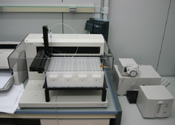 The spectrophotometer comes equipped with all the diode-array advantages - fast scanning, excellent sensitivity, virtually absolute wavelength reproducibility, exceptional ruggedness and reliability, minimum maintenance and open sample area, and significant improvements in optical performance. Better than two nanometer resolution, wavelength range of 190 to 1100 nm and less than 0.03 % stray light is standard.
The spectrophotometer comes equipped with all the diode-array advantages - fast scanning, excellent sensitivity, virtually absolute wavelength reproducibility, exceptional ruggedness and reliability, minimum maintenance and open sample area, and significant improvements in optical performance. Better than two nanometer resolution, wavelength range of 190 to 1100 nm and less than 0.03 % stray light is standard.Flexible accessories - Built-in interfaces for interconnectivity with accessories - Agilent's multicell transport, Peltier thermostatted cell holder, sipper system, or autosampler for example, and Gilson autosamplers, Labsphere diffuse reflectance accessories, or fiber optics couplers from Custom Sensors & Technology. Stable optics - Thermally stable ceramic spectrograph with one nanometer slit width from 190 - 1100 nm.
PHOTO-REACTOR: Side irradiation model (LZC-5)
 UV-Visible exposure tools for controlled irradiation of a wide range of materials.This unit is recommended for customers who only use liquid samples and who therefore prefer side irradiation. The irradiation chamber is approximately 12 inches wide, 12 inches deep and 8.5 inches high. Two switches allow control of the lamps used (8 lamps, 4 each side). An exhaust is needed when using UVC (254 nm) lamps. Fan is included. Different wavelength ranges in the UV and visible regions are available. The irradiation chamber is air-cooled, and the air flow design stabilizes the temperature about 3-4 degrees Celsius above room temperature.
UV-Visible exposure tools for controlled irradiation of a wide range of materials.This unit is recommended for customers who only use liquid samples and who therefore prefer side irradiation. The irradiation chamber is approximately 12 inches wide, 12 inches deep and 8.5 inches high. Two switches allow control of the lamps used (8 lamps, 4 each side). An exhaust is needed when using UVC (254 nm) lamps. Fan is included. Different wavelength ranges in the UV and visible regions are available. The irradiation chamber is air-cooled, and the air flow design stabilizes the temperature about 3-4 degrees Celsius above room temperature.
SP1 TM HPFC FLASH chromatography purification system.
 SP1 system is the latest FLASH chromatography technology for faster and easier purification of compounds in the range of milligrams to tens of grams. The system is equipped with four columns accommodating the broadest range of cartridge sizes. The SP1 system has a unique software features, including TLC-to-gradient with optimal loading, Wizard, Solvent and waste Monitoring, UV detector and the option of On-the-fly programming, which permits the change of the gradient while the purification is running.
SP1 system is the latest FLASH chromatography technology for faster and easier purification of compounds in the range of milligrams to tens of grams. The system is equipped with four columns accommodating the broadest range of cartridge sizes. The SP1 system has a unique software features, including TLC-to-gradient with optimal loading, Wizard, Solvent and waste Monitoring, UV detector and the option of On-the-fly programming, which permits the change of the gradient while the purification is running.
Laser Flash Photolysis Model mLFP-111 Luzchem, Nd-YAG Brilliant Quantel.
 This transient absorption spectrometer has been developed for spectroscopic and kinetic laser flash photolysis measurements. It includes a ceramic xenon light source; 125 mm monochromator; Tektronix 9-bit digitizer TDS-3000 series with 300 MHz bandwidth; compact photomultiplier and power supply, Pentium computer with 17" monitor and back-up drive, cell holder and fiber optic connectors, fiber optic sensor for laser-sensing pretrigger signal, computer interfaces and the software needed to operate the system. The mLFP-111 instrument does not include the laser, but generates 5 volt trigger pulses suitable for most lasers, including the two-pulse sequence required for YAG lasers (flash lamps and Q-switch), with programmable frequency and delay. The m-LFP 111 is capable of recording all the transient signals normally acquired with conventional laser flash photolysis (LFP) systems, but in addition it can perform much better in long time scales.A nanosecond laser (Q-switched Nd:YAG laser, Brilliant) complements the laser flash photolysis system.
This transient absorption spectrometer has been developed for spectroscopic and kinetic laser flash photolysis measurements. It includes a ceramic xenon light source; 125 mm monochromator; Tektronix 9-bit digitizer TDS-3000 series with 300 MHz bandwidth; compact photomultiplier and power supply, Pentium computer with 17" monitor and back-up drive, cell holder and fiber optic connectors, fiber optic sensor for laser-sensing pretrigger signal, computer interfaces and the software needed to operate the system. The mLFP-111 instrument does not include the laser, but generates 5 volt trigger pulses suitable for most lasers, including the two-pulse sequence required for YAG lasers (flash lamps and Q-switch), with programmable frequency and delay. The m-LFP 111 is capable of recording all the transient signals normally acquired with conventional laser flash photolysis (LFP) systems, but in addition it can perform much better in long time scales.A nanosecond laser (Q-switched Nd:YAG laser, Brilliant) complements the laser flash photolysis system.
|
2D Materials Laboratory |
|
Optical microscope Nikon Eclipse LV-100
 Manual optical microscope with episcopy (reflection) and transmission (transmission) modes. Includes objectives of high numerical aperture Fluor Plan (10x, 20x, 50x and 100x) and a DS-Fi3 CMOS high sensitivity high-resolution color digital camera (5.9 megapixel). This optical microscope is intended for the inspection of samples in an inert atmosphere and also allows to perform quantitative optical microscopy in thin films in combination with a set of band-pass filters in the visible spectrum.
Manual optical microscope with episcopy (reflection) and transmission (transmission) modes. Includes objectives of high numerical aperture Fluor Plan (10x, 20x, 50x and 100x) and a DS-Fi3 CMOS high sensitivity high-resolution color digital camera (5.9 megapixel). This optical microscope is intended for the inspection of samples in an inert atmosphere and also allows to perform quantitative optical microscopy in thin films in combination with a set of band-pass filters in the visible spectrum.
|
Scientific workstations |
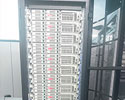 It is a Super Hybrid Computer Cluster with the following services:
It is a Super Hybrid Computer Cluster with the following services: - Servers like compute nodes based on Intel Xeon technology (20), and 6 Intel I7 - Servers like compute nodes based on AMD Opteron technology (4) - Gigabit connection network through Cisco Catalyst Switch 3560G - The cluster includes 268 calculation cores and a total memory of 542 GB offering a peak performance (Rpeak) of 900 GLOPS, which is almost a TFLOP peak performance added. - Storage consists of 66 TB on serial ATA 2 disks More info |

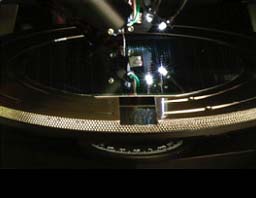 Vertical Laminar Flow Bench with containment to deliver an ultraclean laminar airflow over a working bench to protect manipulated products from dust, from environment contamination and from cross contamination in the working area. All over pressure zones are surrounded by under negative pressure to prevent any leak back into the room or the clean zones of the cabinet. An additional air flow enters from the front to create an air barrier which brings protection to operator and to lab environment. The unit is provided with two HEPA-14 filters, one for the downflow and another for the exhaust. 70% of the air is recirculated thus minimizing filter clogging and the other 30% is expelled through HEPA-14 filter at top of the unit.
Vertical Laminar Flow Bench with containment to deliver an ultraclean laminar airflow over a working bench to protect manipulated products from dust, from environment contamination and from cross contamination in the working area. All over pressure zones are surrounded by under negative pressure to prevent any leak back into the room or the clean zones of the cabinet. An additional air flow enters from the front to create an air barrier which brings protection to operator and to lab environment. The unit is provided with two HEPA-14 filters, one for the downflow and another for the exhaust. 70% of the air is recirculated thus minimizing filter clogging and the other 30% is expelled through HEPA-14 filter at top of the unit.


 Chemat Technologies model KW-4A is a compact spin coater for precise and uniform deposition of thin films and coatings (metal oxide thin films, polymer coatings and metal organic thin films).
Chemat Technologies model KW-4A is a compact spin coater for precise and uniform deposition of thin films and coatings (metal oxide thin films, polymer coatings and metal organic thin films). High vacuum chambers integrated in a nitrogen glove box equipped with a water-cooled turbo molecular pump (pressure below 10-6 mbar). The deposition system consists in 6 individual thermal sources with alumina crucible and integrated shutter. Typical deposition rates varies between 0.01 and 50 Å/s, with a temperature range 50 °C - 800 °C and stability < 0.1 °C. The system is water cooled, with 3 temperature controlled power supplies, which allow co-evaporation of different materials. 3 water-cooled quartz crystal microbalance (QCM) sensors are used to measure the rate of material evaporation with a 1 Å resolution.
High vacuum chambers integrated in a nitrogen glove box equipped with a water-cooled turbo molecular pump (pressure below 10-6 mbar). The deposition system consists in 6 individual thermal sources with alumina crucible and integrated shutter. Typical deposition rates varies between 0.01 and 50 Å/s, with a temperature range 50 °C - 800 °C and stability < 0.1 °C. The system is water cooled, with 3 temperature controlled power supplies, which allow co-evaporation of different materials. 3 water-cooled quartz crystal microbalance (QCM) sensors are used to measure the rate of material evaporation with a 1 Å resolution.
 A vacuum chamber placed inside the glove box can achieve high vacuum, at pressures bellow 10-6 mbar. It is used for the thermal evaporation of metals (Al, Ba, Ca, Ag, Au) and other compounds (LiF, Cs2CO3) onto the surface of solids substrates.
A vacuum chamber placed inside the glove box can achieve high vacuum, at pressures bellow 10-6 mbar. It is used for the thermal evaporation of metals (Al, Ba, Ca, Ag, Au) and other compounds (LiF, Cs2CO3) onto the surface of solids substrates. Plasma systems for cleaning or surface modification of small components and substrates. The system is can use different gasses (O2, N2, H2, Ar) for a variety of applications. As well as plasma cleaning and degreasing, etching and coating are all easily carried out with this system. The maximum power is 300 W, and the inner chamber dimensions are 190 x 190 x 320 mm. The plasma system is computer-controlled for virtualization of the process data. Process diagrams can be stored locally or via network.
Plasma systems for cleaning or surface modification of small components and substrates. The system is can use different gasses (O2, N2, H2, Ar) for a variety of applications. As well as plasma cleaning and degreasing, etching and coating are all easily carried out with this system. The maximum power is 300 W, and the inner chamber dimensions are 190 x 190 x 320 mm. The plasma system is computer-controlled for virtualization of the process data. Process diagrams can be stored locally or via network.



 An Ambios-Technology profilometer model XP-1, placed on a vibration isolation table.
An Ambios-Technology profilometer model XP-1, placed on a vibration isolation table. Computer controlled and user programmable Langmuir and Langmuir-Blodgett (LB) instrument for automated Langmuir film experiments and for unsupervised deposition of normal multilayers onto solid substrates.
Computer controlled and user programmable Langmuir and Langmuir-Blodgett (LB) instrument for automated Langmuir film experiments and for unsupervised deposition of normal multilayers onto solid substrates. A computer controlled NIMA Langmuir trough (type 702BAM) equipped with a Wilhelmy plate can register surface pressure-area isotherms with a resolution better than 0.1 mN/m. Furthermore, the Langmuir monolayer surface is continuously imaged with 2 µm lateral resolution, during the compression isotherm, with a Brewster angle microscope type EP3-BAM from NFT-Nanofilm Technologie, GmbH (Göttingen, Germany). This microscope can also be used for imaging of the Langmuir-Blodgett (LB) films transferred onto solid substrates.
A computer controlled NIMA Langmuir trough (type 702BAM) equipped with a Wilhelmy plate can register surface pressure-area isotherms with a resolution better than 0.1 mN/m. Furthermore, the Langmuir monolayer surface is continuously imaged with 2 µm lateral resolution, during the compression isotherm, with a Brewster angle microscope type EP3-BAM from NFT-Nanofilm Technologie, GmbH (Göttingen, Germany). This microscope can also be used for imaging of the Langmuir-Blodgett (LB) films transferred onto solid substrates.





 A Magneto-Optical Kerr Effect (MOKE) set-up allows to perform experiments in a temperature range between (4-400) K.
A Magneto-Optical Kerr Effect (MOKE) set-up allows to perform experiments in a temperature range between (4-400) K. Nanotec Scanning Probe Microscope (SPM) equipped with a Phase Lock Loop, operates at room temperature in air or at high vacuum. Operating modes available are scanning tunneling microscopy (STM), atomic force microscopy (AFM, in Dynamic, Contact, Friction and Jumping modes), electrostatic force microscopy (EFM), conductive AFM (C-AFM) and Local Oxidation Nanolithography. There are scanners for three different areas: 4 x 4 µm2 (XS_SCAN_01), 17 x 17 µm2 (PDC_FAST_08) and closed-loop 63 x 63 µm2 (CL_SCAN_17).
Nanotec Scanning Probe Microscope (SPM) equipped with a Phase Lock Loop, operates at room temperature in air or at high vacuum. Operating modes available are scanning tunneling microscopy (STM), atomic force microscopy (AFM, in Dynamic, Contact, Friction and Jumping modes), electrostatic force microscopy (EFM), conductive AFM (C-AFM) and Local Oxidation Nanolithography. There are scanners for three different areas: 4 x 4 µm2 (XS_SCAN_01), 17 x 17 µm2 (PDC_FAST_08) and closed-loop 63 x 63 µm2 (CL_SCAN_17).
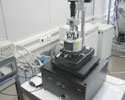 The microscope allows to acquire images on atomic, nanoscopic and macroscopic scales to measure surface characteristics as topography or adhesion. It works in air at room temperature in different operating modes: Scanning tunneling microscopy (STM), magnetic force microscopy (MFM) and atomic force microscopy (AFM). As an AFM it can be used in Dynamic (also known as tapping), Contact and Torsion modes. The equip is interfaced with a home-made voltage amplifier to perform Local Oxidation Nanolithography. A liquid cell is also available for electrochemical measurements. Two scanners can be used for different scanning areas: 10 x10 µm2 (manual 7337ENV) and 100 x 100 µm2 (fully motorized 8462JV).
The microscope allows to acquire images on atomic, nanoscopic and macroscopic scales to measure surface characteristics as topography or adhesion. It works in air at room temperature in different operating modes: Scanning tunneling microscopy (STM), magnetic force microscopy (MFM) and atomic force microscopy (AFM). As an AFM it can be used in Dynamic (also known as tapping), Contact and Torsion modes. The equip is interfaced with a home-made voltage amplifier to perform Local Oxidation Nanolithography. A liquid cell is also available for electrochemical measurements. Two scanners can be used for different scanning areas: 10 x10 µm2 (manual 7337ENV) and 100 x 100 µm2 (fully motorized 8462JV).

 This goniometer is a powerful tool for measuring contact angle and surface energy. This device includes DROPimage Standard softward as well as a fiber optic illuminator, 3-axis leveling stage, high-speed F4 Series digital camera, microsyringe fixture and assembly for manual dispensing. The system is improved with an automated dispensing system and manual tilting base options.
This goniometer is a powerful tool for measuring contact angle and surface energy. This device includes DROPimage Standard softward as well as a fiber optic illuminator, 3-axis leveling stage, high-speed F4 Series digital camera, microsyringe fixture and assembly for manual dispensing. The system is improved with an automated dispensing system and manual tilting base options. The variable angle ellipsometer allows to measure as the main application: the thickness calculation of molecular materials, metals and inorganic materials layers, being its accuracy between the 0.1 nm from µm. Also the ellipsometer give the optical properties of the measurable samples giving information about the electronic structure like GAP position in molecular and inorganic semiconductors. The size spot is 65x80 ums and it is possible to check roughness samples. The measurable spectra is from 190 nm to 1700 nm.
The variable angle ellipsometer allows to measure as the main application: the thickness calculation of molecular materials, metals and inorganic materials layers, being its accuracy between the 0.1 nm from µm. Also the ellipsometer give the optical properties of the measurable samples giving information about the electronic structure like GAP position in molecular and inorganic semiconductors. The size spot is 65x80 ums and it is possible to check roughness samples. The measurable spectra is from 190 nm to 1700 nm.
 LbL technique is one of the most important techniques for the preparation of mixed multilayer films, taking advantage of the electrostatic interactions between the building blocks that compose the layers, in order to get a good control in the intercalation of the monolayers.
LbL technique is one of the most important techniques for the preparation of mixed multilayer films, taking advantage of the electrostatic interactions between the building blocks that compose the layers, in order to get a good control in the intercalation of the monolayers.

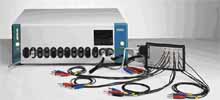 The potentiostat/galvanostat instruments are state of the art instrumentation that can be used for virtually all electrochemical applications.
The potentiostat/galvanostat instruments are state of the art instrumentation that can be used for virtually all electrochemical applications.






